clutch DODGE DART 2015 PF / 1.G User Guide
[x] Cancel search | Manufacturer: DODGE, Model Year: 2015, Model line: DART, Model: DODGE DART 2015 PF / 1.GPages: 664, PDF Size: 16.96 MB
Page 444 of 664
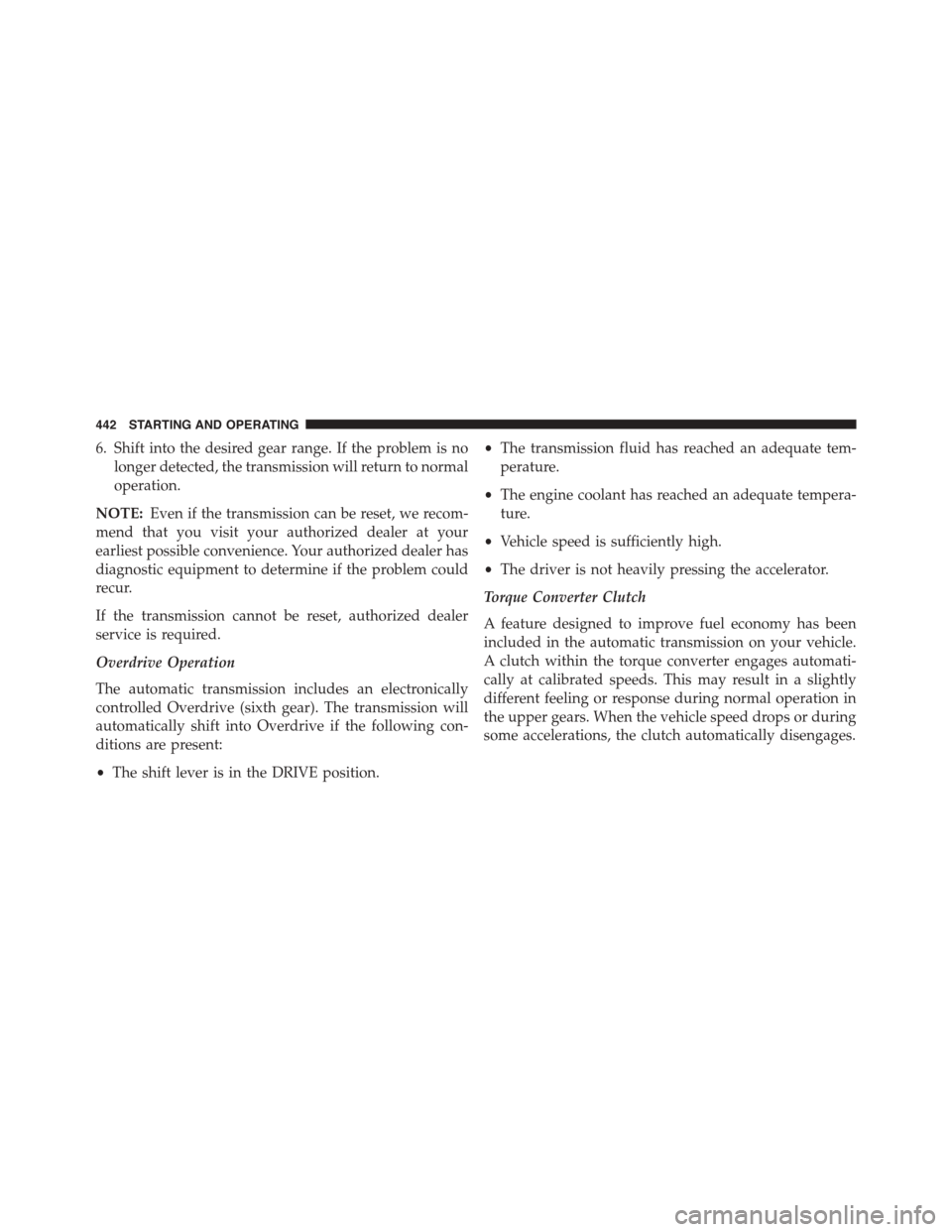
6. Shift into the desired gear range. If the problem is no
longer detected, the transmission will return to normal
operation.
NOTE:Even if the transmission can be reset, we recom-
mend that you visit your authorized dealer at your
earliest possible convenience. Your authorized dealer has
diagnostic equipment to determine if the problem could
recur.
If the transmission cannot be reset, authorized dealer
service is required.
Overdrive Operation
The automatic transmission includes an electronically
controlled Overdrive (sixth gear). The transmission will
automatically shift into Overdrive if the following con-
ditions are present:
•The shift lever is in the DRIVE position.
•The transmission fluid has reached an adequate tem-
perature.
•The engine coolant has reached an adequate tempera-
ture.
•Vehicle speed is sufficiently high.
•The driver is not heavily pressing the accelerator.
Torque Converter Clutch
A feature designed to improve fuel economy has been
included in the automatic transmission on your vehicle.
A clutch within the torque converter engages automati-
cally at calibrated speeds. This may result in a slightly
different feeling or response during normal operation in
the upper gears. When the vehicle speed drops or during
some accelerations, the clutch automatically disengages.
442 STARTING AND OPERATING
Page 445 of 664
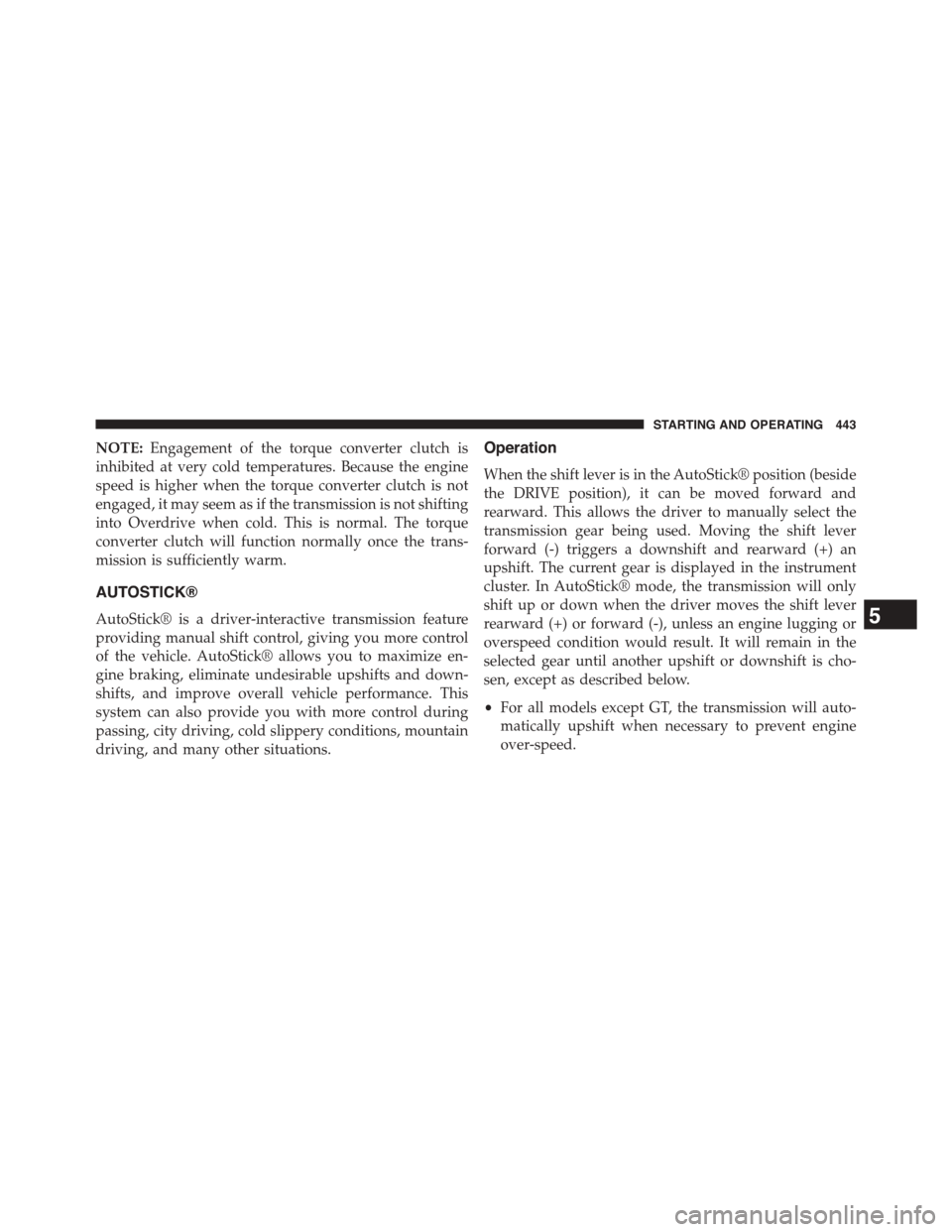
NOTE:Engagement of the torque converter clutch is
inhibited at very cold temperatures. Because the engine
speed is higher when the torque converter clutch is not
engaged, it may seem as if the transmission is not shifting
into Overdrive when cold. This is normal. The torque
converter clutch will function normally once the trans-
mission is sufficiently warm.
AUTOSTICK®
AutoStick® is a driver-interactive transmission feature
providing manual shift control, giving you more control
of the vehicle. AutoStick® allows you to maximize en-
gine braking, eliminate undesirable upshifts and down-
shifts, and improve overall vehicle performance. This
system can also provide you with more control during
passing, city driving, cold slippery conditions, mountain
driving, and many other situations.
Operation
When the shift lever is in the AutoStick® position (beside
the DRIVE position), it can be moved forward and
rearward. This allows the driver to manually select the
transmission gear being used. Moving the shift lever
forward (-) triggers a downshift and rearward (+) an
upshift. The current gear is displayed in the instrument
cluster. In AutoStick® mode, the transmission will only
shift up or down when the driver moves the shift lever
rearward (+) or forward (-), unless an engine lugging or
overspeed condition would result. It will remain in the
selected gear until another upshift or downshift is cho-
sen, except as described below.
•For all models except GT, the transmission will auto-
matically upshift when necessary to prevent engine
over-speed.
5
STARTING AND OPERATING 443
Page 523 of 664
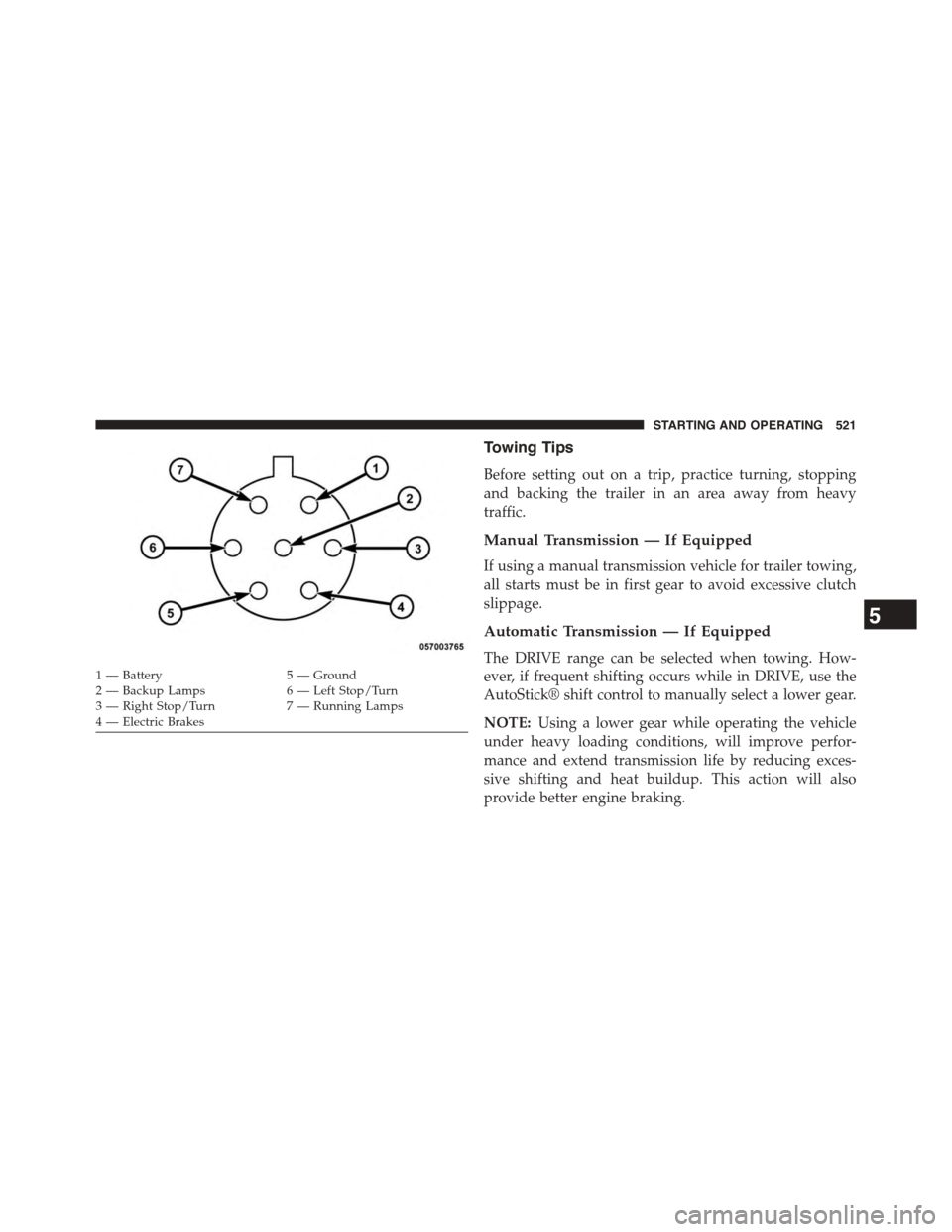
Towing Tips
Before setting out on a trip, practice turning, stopping
and backing the trailer in an area away from heavy
traffic.
Manual Transmission — If Equipped
If using a manual transmission vehicle for trailer towing,
all starts must be in first gear to avoid excessive clutch
slippage.
Automatic Transmission — If Equipped
The DRIVE range can be selected when towing. How-
ever, if frequent shifting occurs while in DRIVE, use the
AutoStick® shift control to manually select a lower gear.
NOTE:Using a lower gear while operating the vehicle
under heavy loading conditions, will improve perfor-
mance and extend transmission life by reducing exces-
sive shifting and heat buildup. This action will also
provide better engine braking.
1—Battery5—Ground2—BackupLamps6—LeftStop/Turn3—RightStop/Turn7—RunningLamps4 — Electric Brakes
5
STARTING AND OPERATING 521
Page 557 of 664
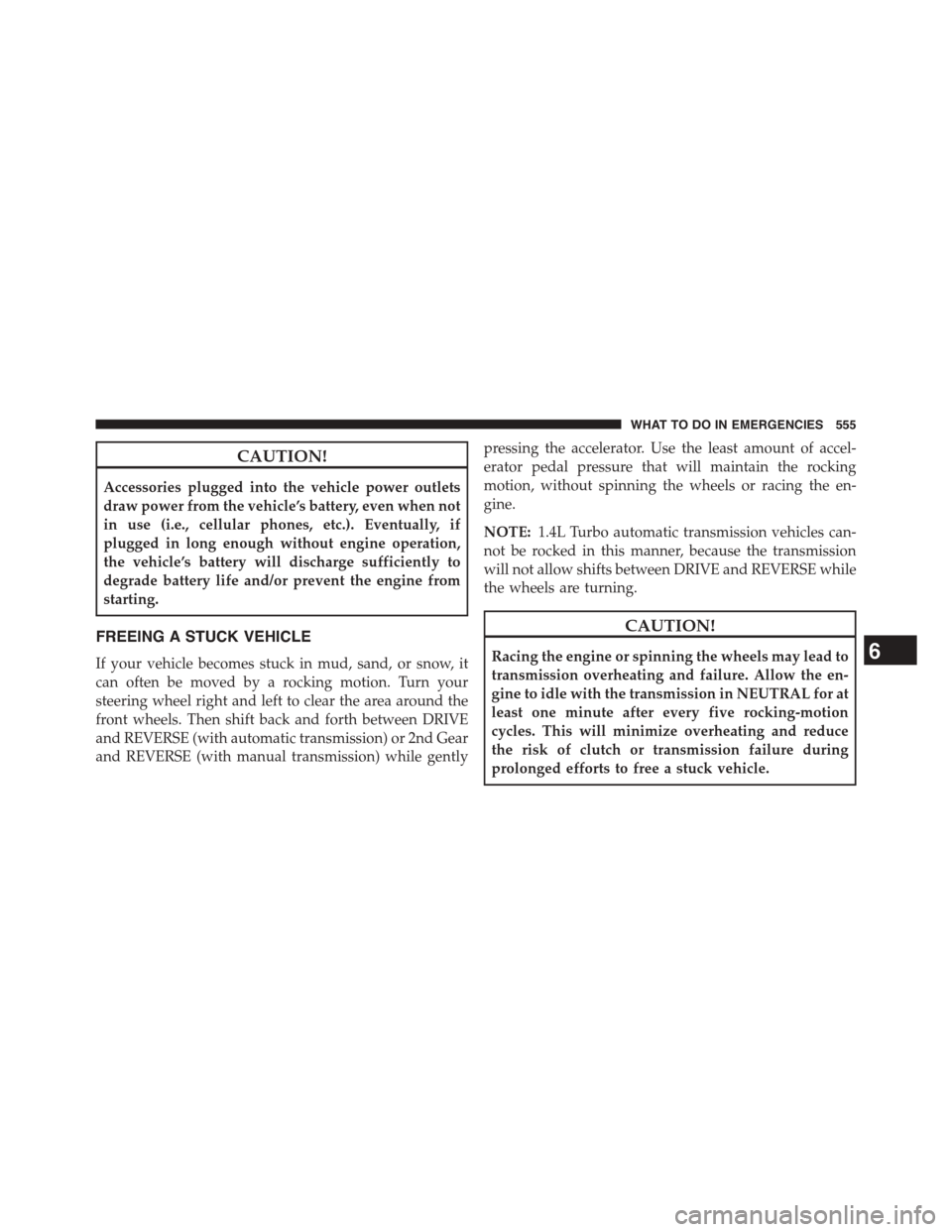
CAUTION!
Accessories plugged into the vehicle power outlets
draw power from the vehicle’s battery, even when not
in use (i.e., cellular phones, etc.). Eventually, if
plugged in long enough without engine operation,
the vehicle’s battery will discharge sufficiently to
degrade battery life and/or prevent the engine from
starting.
FREEING A STUCK VEHICLE
If your vehicle becomes stuck in mud, sand, or snow, it
can often be moved by a rocking motion. Turn your
steering wheel right and left to clear the area around the
front wheels. Then shift back and forth between DRIVE
and REVERSE (with automatic transmission) or 2nd Gear
and REVERSE (with manual transmission) while gently
pressing the accelerator. Use the least amount of accel-
erator pedal pressure that will maintain the rocking
motion, without spinning the wheels or racing the en-
gine.
NOTE:1.4L Turbo automatic transmission vehicles can-
not be rocked in this manner, because the transmission
will not allow shifts between DRIVE and REVERSE while
the wheels are turning.
CAUTION!
Racing the engine or spinning the wheels may lead to
transmission overheating and failure. Allow the en-
gine to idle with the transmission in NEUTRAL for at
least one minute after every five rocking-motion
cycles. This will minimize overheating and reduce
the risk of clutch or transmission failure during
prolonged efforts to free a stuck vehicle.
6
WHAT TO DO IN EMERGENCIES 555
Page 563 of 664
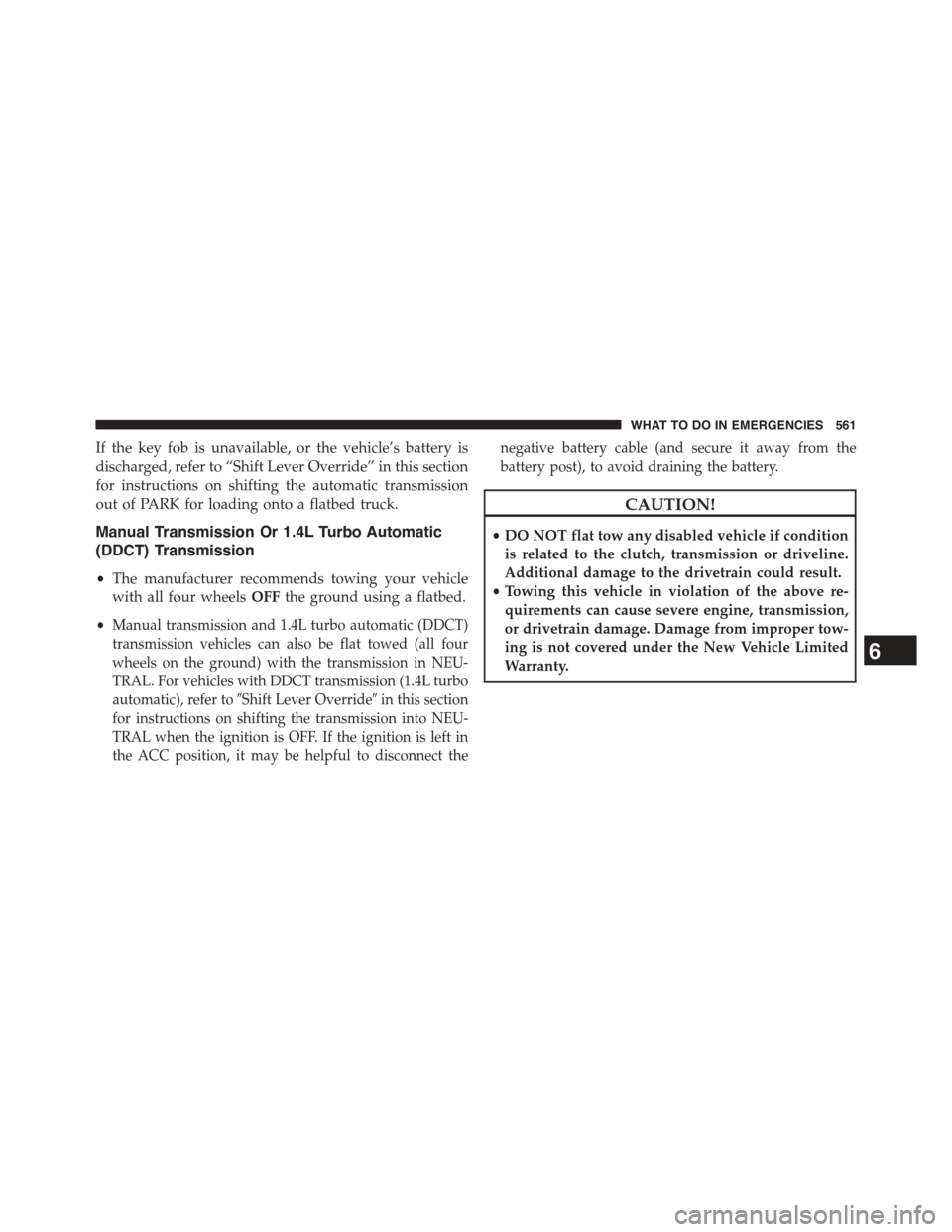
If the key fob is unavailable, or the vehicle’s battery is
discharged, refer to “Shift Lever Override” in this section
for instructions on shifting the automatic transmission
out of PARK for loading onto a flatbed truck.
Manual Transmission Or 1.4L Turbo Automatic
(DDCT) Transmission
•The manufacturer recommends towing your vehicle
with all four wheelsOFFthe ground using a flatbed.
•Manual transmission and 1.4L turbo automatic (DDCT)
transmission vehicles can also be flat towed (all four
wheels on the ground) with the transmission in NEU-
TRAL. For vehicles with DDCT transmission (1.4L turbo
automatic), refer to#Shift Lever Override#in this section
for instructions on shifting the transmission into NEU-
TRAL when the ignition is OFF. If the ignition is left in
the ACC position, it may be helpful to disconnect the
negative battery cable (and secure it away from the
battery post), to avoid draining the battery.
CAUTION!
•DO NOT flat tow any disabled vehicle if condition
is related to the clutch, transmission or driveline.
Additional damage to the drivetrain could result.
•Towing this vehicle in violation of the above re-
quirements can cause severe engine, transmission,
or drivetrain damage. Damage from improper tow-
ing is not covered under the New Vehicle Limited
Warranty.6
WHAT TO DO IN EMERGENCIES 561
Page 593 of 664
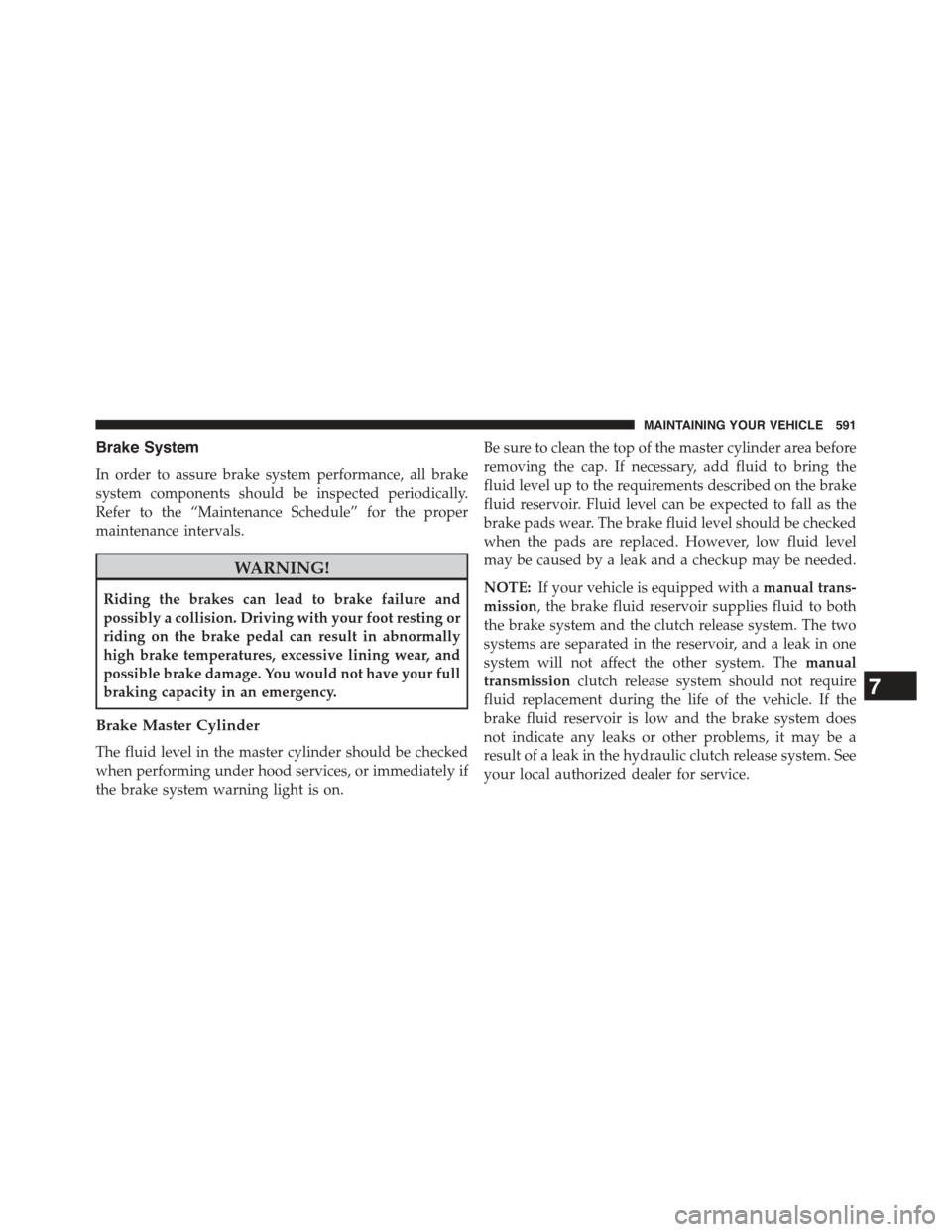
Brake System
In order to assure brake system performance, all brake
system components should be inspected periodically.
Refer to the “Maintenance Schedule” for the proper
maintenance intervals.
WARNING!
Riding the brakes can lead to brake failure and
possibly a collision. Driving with your foot resting or
riding on the brake pedal can result in abnormally
high brake temperatures, excessive lining wear, and
possible brake damage. You would not have your full
braking capacity in an emergency.
Brake Master Cylinder
The fluid level in the master cylinder should be checked
when performing under hood services, or immediately if
the brake system warning light is on.
Be sure to clean the top of the master cylinder area before
removing the cap. If necessary, add fluid to bring the
fluid level up to the requirements described on the brake
fluid reservoir. Fluid level can be expected to fall as the
brake pads wear. The brake fluid level should be checked
when the pads are replaced. However, low fluid level
may be caused by a leak and a checkup may be needed.
NOTE:If your vehicle is equipped with amanual trans-
mission, the brake fluid reservoir supplies fluid to both
the brake system and the clutch release system. The two
systems are separated in the reservoir, and a leak in one
system will not affect the other system. Themanual
transmissionclutch release system should not require
fluid replacement during the life of the vehicle. If the
brake fluid reservoir is low and the brake system does
not indicate any leaks or other problems, it may be a
result of a leak in the hydraulic clutch release system. See
your local authorized dealer for service.
7
MAINTAINING YOUR VEHICLE 591
Page 595 of 664
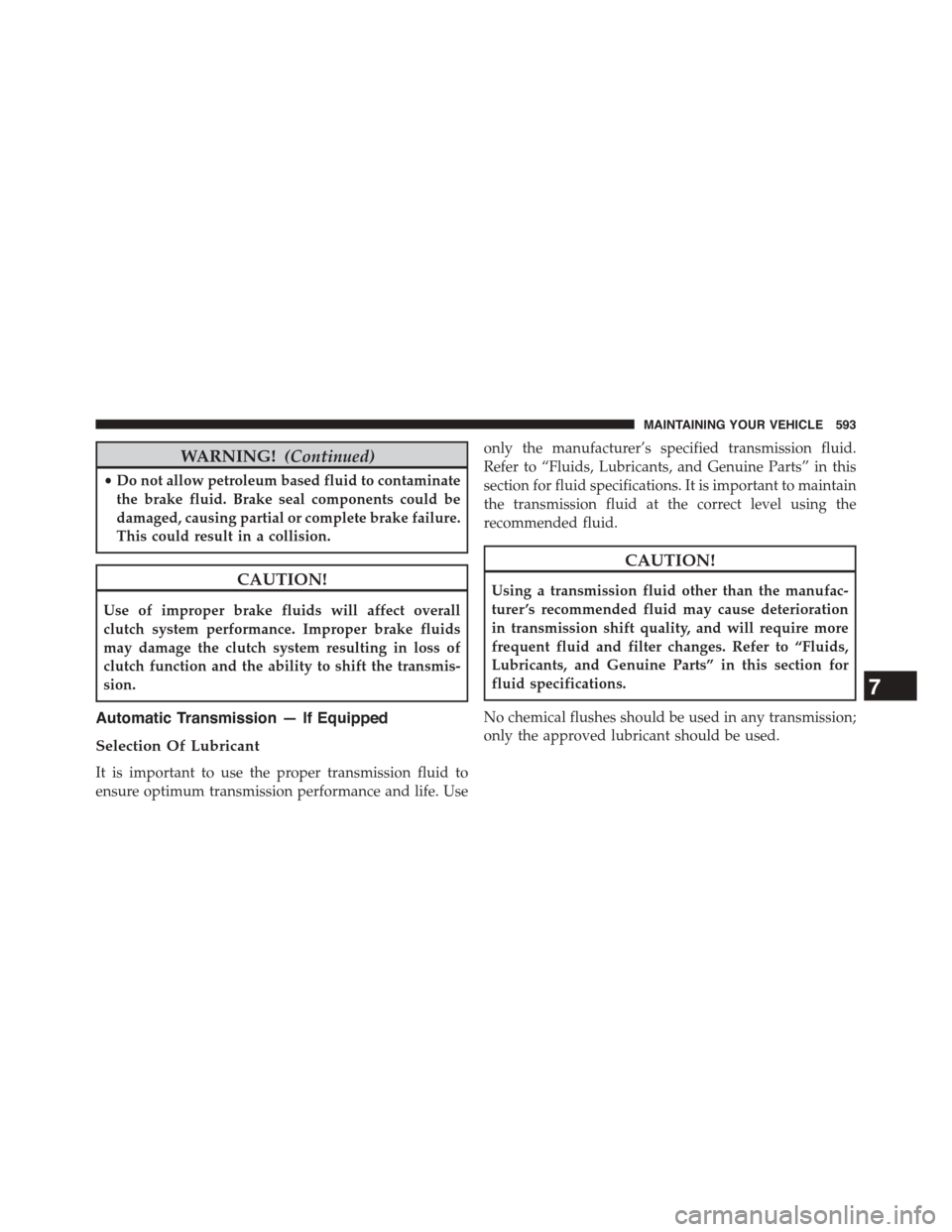
WARNING!(Continued)
•Do not allow petroleum based fluid to contaminate
the brake fluid. Brake seal components could be
damaged, causing partial or complete brake failure.
This could result in a collision.
CAUTION!
Use of improper brake fluids will affect overall
clutch system performance. Improper brake fluids
may damage the clutch system resulting in loss of
clutch function and the ability to shift the transmis-
sion.
Automatic Transmission — If Equipped
Selection Of Lubricant
It is important to use the proper transmission fluid to
ensure optimum transmission performance and life. Use
only the manufacturer’s specified transmission fluid.
Refer to “Fluids, Lubricants, and Genuine Parts” in this
section for fluid specifications. It is important to maintain
the transmission fluid at the correct level using the
recommended fluid.
CAUTION!
Using a transmission fluid other than the manufac-
turer ’s recommended fluid may cause deterioration
in transmission shift quality, and will require more
frequent fluid and filter changes. Refer to “Fluids,
Lubricants, and Genuine Parts” in this section for
fluid specifications.
No chemical flushes should be used in any transmission;
only the approved lubricant should be used.
7
MAINTAINING YOUR VEHICLE 593
Page 608 of 664
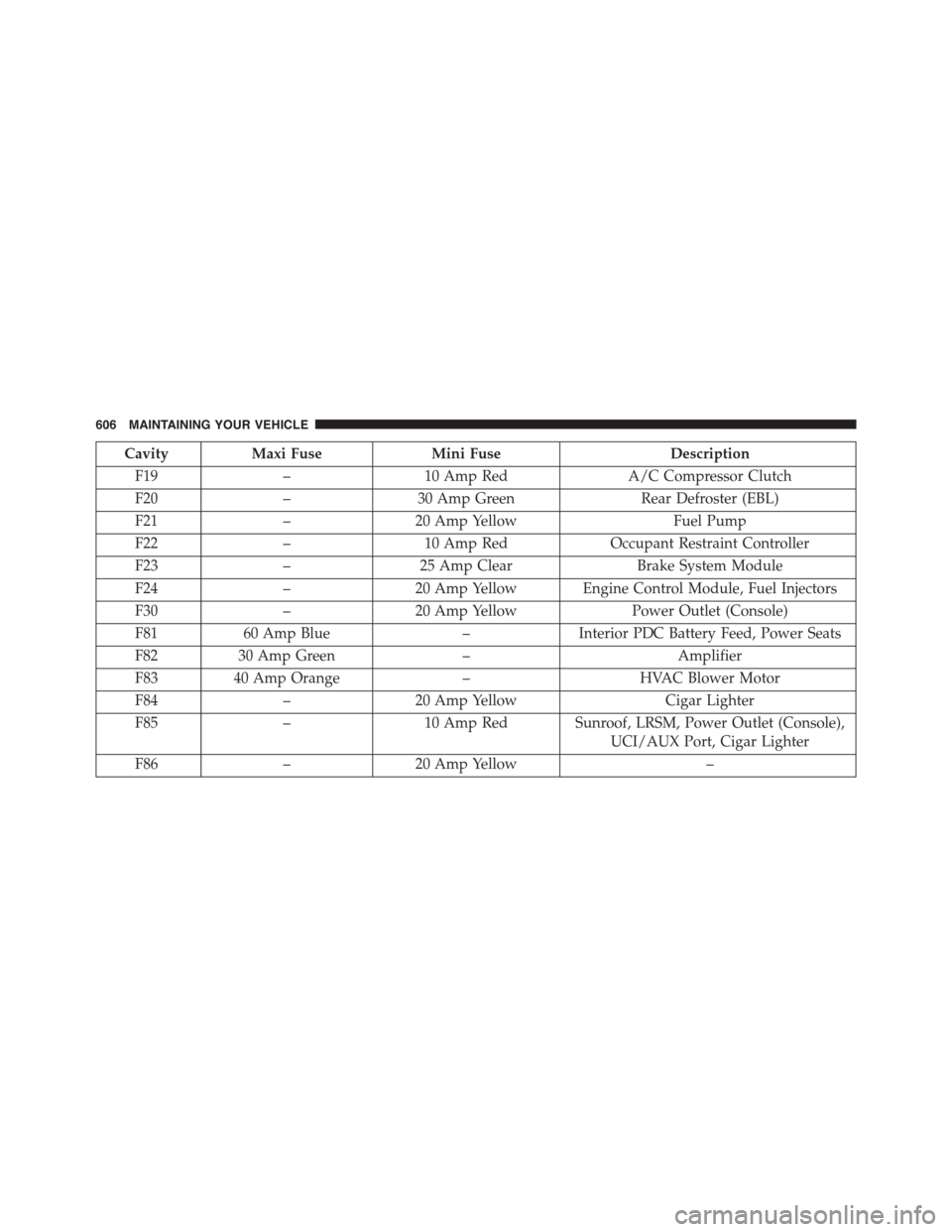
CavityMaxi FuseMini FuseDescription
F19–10 Amp RedA/C Compressor Clutch
F20–30 Amp GreenRear Defroster (EBL)
F21–20 Amp YellowFuel Pump
F22–10 Amp RedOccupant Restraint Controller
F23–25 Amp ClearBrake System Module
F24–20 Amp Yellow Engine Control Module, Fuel Injectors
F30–20 Amp YellowPower Outlet (Console)
F8160 Amp Blue–Interior PDC Battery Feed, Power Seats
F8230 Amp Green–Amplifier
F8340 Amp Orange–HVAC Blower Motor
F84–20 Amp YellowCigar Lighter
F85–10 Amp Red Sunroof, LRSM, Power Outlet (Console),
UCI/AUX Port, Cigar Lighter
F86–20 Amp Yellow–
606 MAINTAINING YOUR VEHICLE
Page 621 of 664
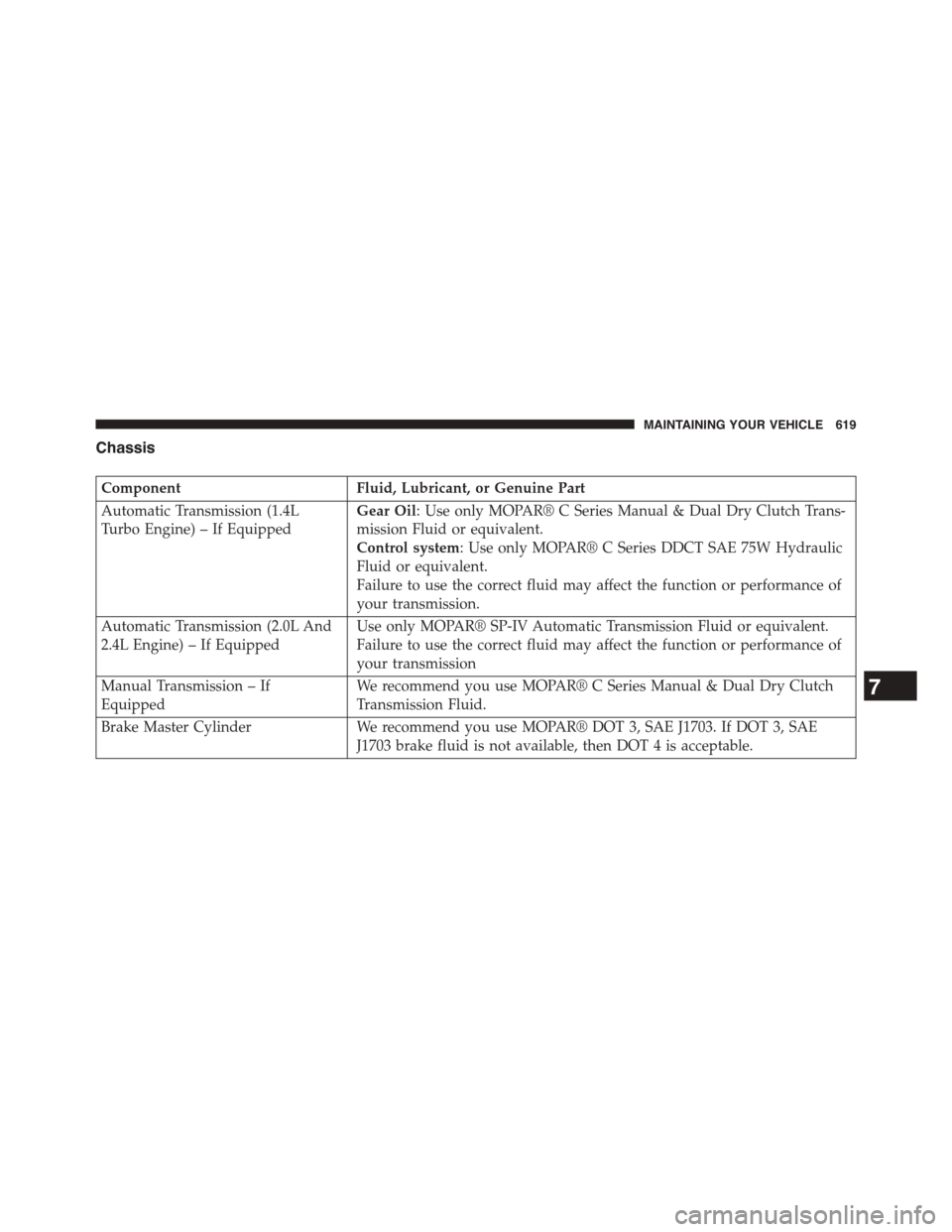
Chassis
ComponentFluid, Lubricant, or Genuine Part
Automatic Transmission (1.4L
Turbo Engine) – If Equipped
Gear Oil: Use only MOPAR® C Series Manual & Dual Dry Clutch Trans-
mission Fluid or equivalent.
Control system: Use only MOPAR® C Series DDCT SAE 75W Hydraulic
Fluid or equivalent.
Failure to use the correct fluid may affect the function or performance of
your transmission.
Automatic Transmission (2.0L And
2.4L Engine) – If Equipped
Use only MOPAR® SP-IV Automatic Transmission Fluid or equivalent.
Failure to use the correct fluid may affect the function or performance of
your transmission
Manual Transmission – If
Equipped
We recommend you use MOPAR® C Series Manual & Dual Dry Clutch
Transmission Fluid.
Brake Master CylinderWe recommend you use MOPAR® DOT 3, SAE J1703. If DOT 3, SAE
J1703 brake fluid is not available, then DOT 4 is acceptable.
7
MAINTAINING YOUR VEHICLE 619
Page 645 of 664
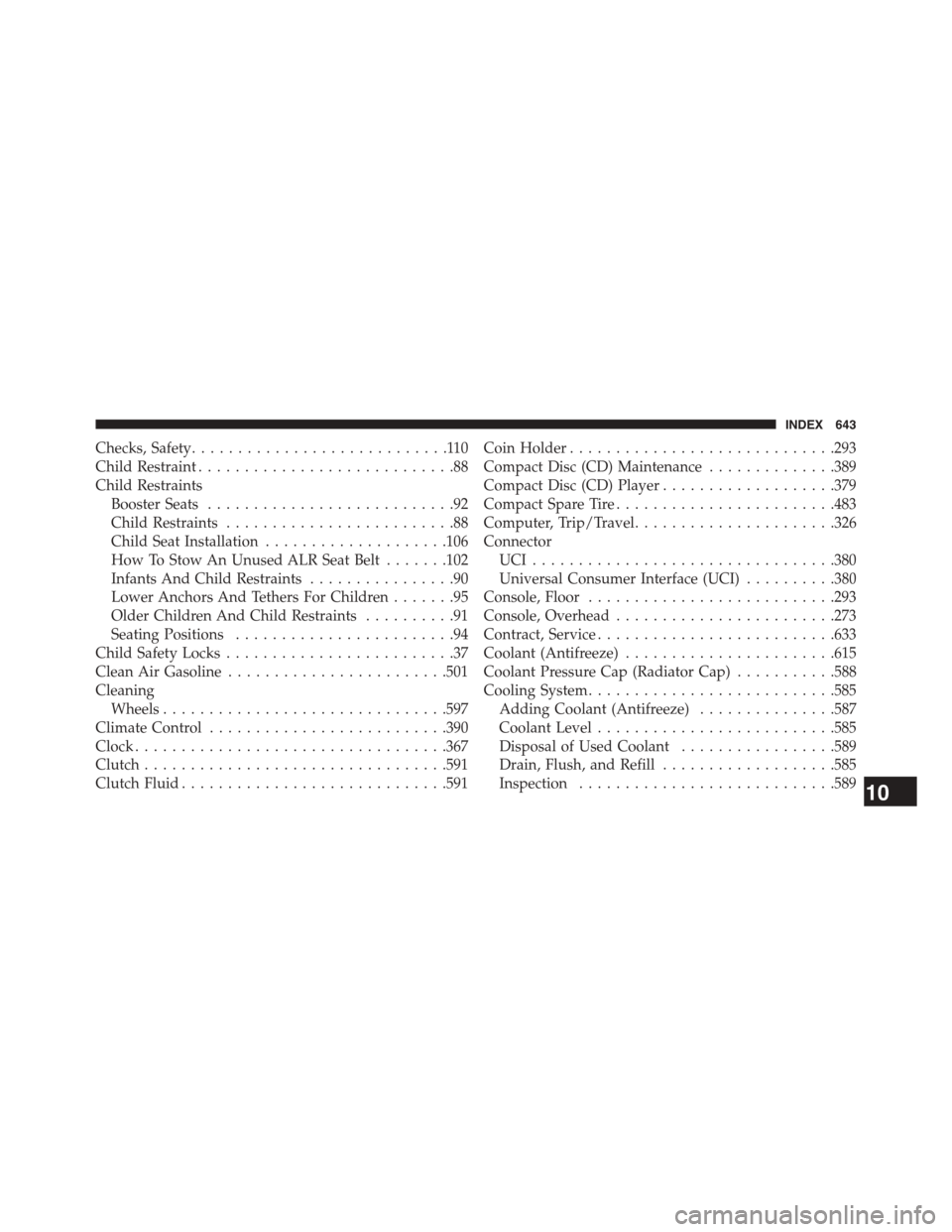
Checks, Safety............................110
Child Restraint............................88
Child Restraints
Booster Seats...........................92
Child Restraints.........................88
Child Seat Installation....................106
How To Stow An Unused ALR Seat Belt.......102
Infants And Child Restraints................90
Lower Anchors And Tethers For Children.......95
Older Children And Child Restraints..........91
Seating Positions........................94
Child Safety Locks.........................37
Clean Air Gasoline........................501
Cleaning
Wheels...............................597
Climate Control..........................390
Clock..................................367
Clutch.................................591
Clutch Fluid.............................591
Coin Holder.............................293
Compact Disc (CD) Maintenance..............389
Compact Disc (CD) Player...................379
Compact Spare Tire........................483
Computer, Trip/Travel......................326
Connector
UCI . . . . . . . . . . . . . . . . . . . . . . . . . . . . . . . ..380
Universal Consumer Interface (UCI)..........380
Console, Floor...........................293
Console, Overhead........................273
Contract, Service..........................633
Coolant (Antifreeze).......................615
Coolant Pressure Cap (Radiator Cap)...........588
Cooling System...........................585
Adding Coolant (Antifreeze)...............587
Coolant Level..........................585
Disposal of Used Coolant.................589
Drain, Flush, and Refill...................585
Inspection............................58910
INDEX 643